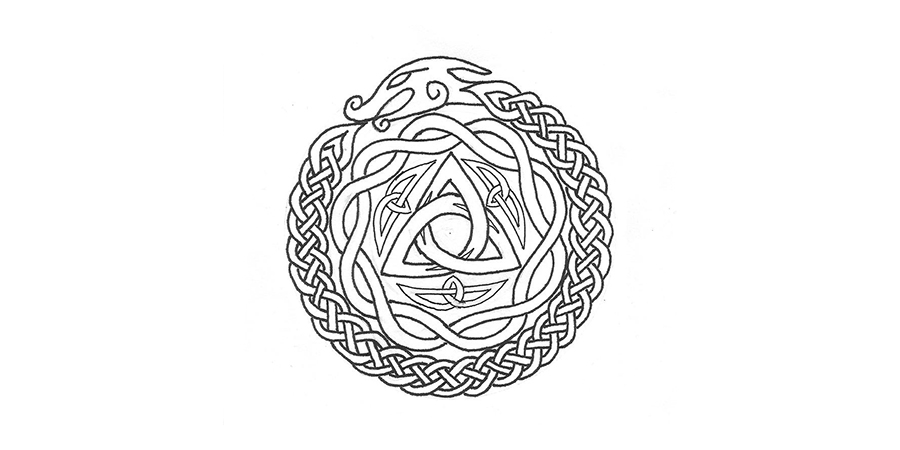Norse mythology refers to the Scandinavian mythological framework that was upheld during and around the time of the Viking Age (c. 790- c. 1100 CE). Before the Norse (a.k.a. the Vikings) converted to Christianity during the Middle Ages, they had their own vibrant native pagan religion that was as harshly beautiful as the Nordic landscape to which it was intimately connected.
The centerpiece of that religion was what we today call “Norse mythology:” the set of religious stories that gave meaning to the Vikings’ lives. These myths revolved around gods and goddesses with fascinating and highly complex characters, such as Odin, Thor, Freya, and Loki.
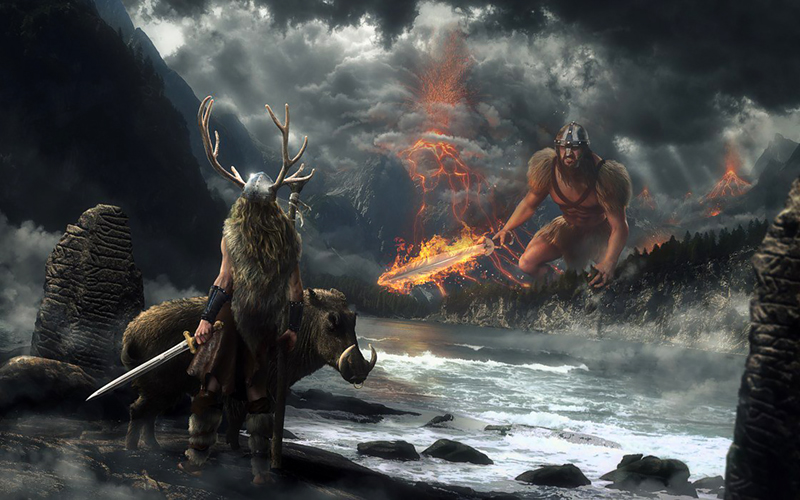
In Norse mythology there are nine worlds. From the center of the Norse cosmos at the heart of the unimaginable emptiness of space – Ginnungagap, where the Norse Creation Saga unfolded, Yggdrasill, a celestial ash tree, sprawls forth… Her three mighty roots drink from the waters of these home worlds, or Níu Heimar in Old Norse. These nine realms include Asgard (The domain of the Æsir gods), The Æsir Gods were strong, beautiful and big compared to ordinary people. They lived longer than the humans, but were not immortal.
Vanaheim (Home to the Vanir gods), Midgard (Realms of Mankind), Alfheim (Home of the Alfar or Elves sometimes divided into two realms), Helheim (Icy domain of the non-warrior dead ruled by the goddess Hel), Jotunheim (Land of the Jotuns, or Frost Giants), Nifleheim (the cold realm at the base of the World Tree), Nidavellir or Svartalfheim (the land of the Dwarves). The molten region called Muspel, or Muspelheim, dwelling place of the Fire Giants and their king the powerful giant Surtur.
Unlike the Greek & Roman myths, these Norse myths can vary drastically in details, names, and spellings depending on their country of origin due to the use of oral tradition rather than written language before the stories and poems that had been anonymously compiled were written down by Snori Sturluson in the 13th century. (The Aesop of the North) Details such as the parentage of Loki have been the subject of scholarly debate for centuries…
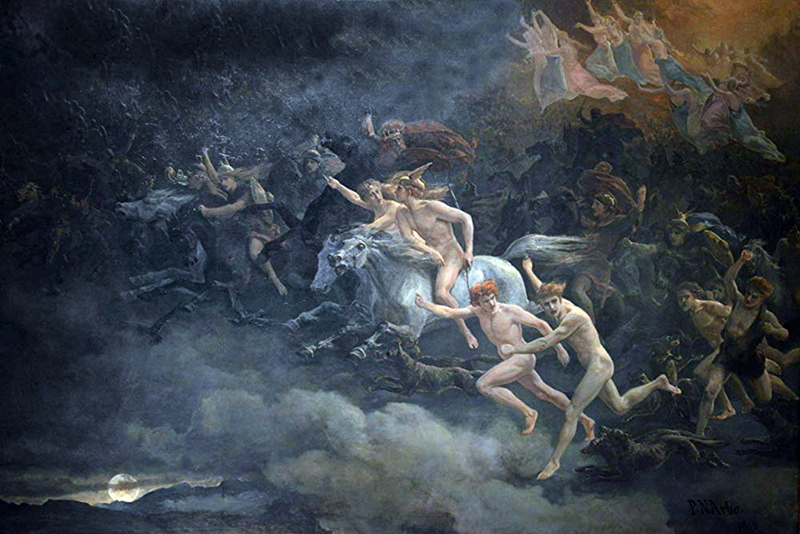
On the one hand, we do have some genuine pre-Christian sources that preserve elements of Scandinavian mythology; most importantly Eddic poetry (poetry from the Poetic Edda compiled in c. 1270 CE, but probably dating back to the pre-Christian era before the 10th century) and skaldic poetry (Viking Age, pre-Christian poetry mainly heard at courts by kings and their retinues), preserved in later Icelandic manuscripts. The Norse worldview as we can best distill from the various sources boils down to the following general idea. There were four phases: the process in which the world – and everything in it – was created; a dynamic phase in which time is started; the destruction of the world in the Ragnarök; and the arising of a new world from the sea.
According to Snorri, before anything else existed there were the opposing realms of icy Niflheim and fiery Muspelheim (which other sources simply call Muspell). Although seemingly safely separated by the empty void Ginnungagap, the cold and heat expanded to meet after all, resulting in Muspelheim’s fire melting the ice, from which two assumingly dripping wet figures emerged: the (proto-)giant Ymir and the cow Audhumla.
By licking the ice Audhumla uncovered Búri, forefather of the gods, whose son Borr teamed up with giant-daughter Bestla to sire the first gods, Odin, Vili, and Vé. These three then took advantage of Ymir’s convenient size by killing him and using his remains to create the world; the earth from his flesh, the sky from his skull, mountains from his bones and the sea from his blood. The first human couple, Ask and Embla, were fashioned out of two trees or pieces of wood.
With humans popping up, a new phase begins; time has started, and all the gods and other creatures and their respective realms are off doing their own thing up until the Ragnarök. The World Tree Yggdrasil, the axis of time and space, stands in the gods’ home realm of Asgard while its roots encompass all the other realms, including Midgard, where the humans reside, and the giants’ abode Jotunheim.
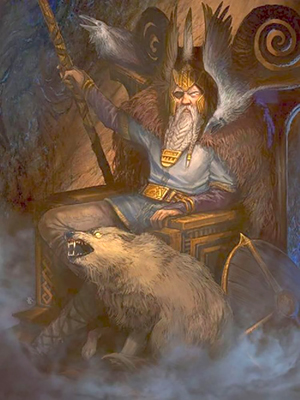 Odin, the supreme Norse god, was the son of Borr and Bestla, king of the Aesir (Æsir, Asynur pl. pronounced “eye-seer”) and lord of Asgard. He was also the god of war, wisdom, magic, poetry, prophecy, victory and the hunt. Odin was called by more than 200 different names revealing his many roles. Among others, he was known as Yggr (terror), Sigfodr (father of Victory) and Alfodr (All Father). When he went out to battle he rode an eight legged horse named Sleipnir. His weapon of choice was a magical spear called Gungnir, fashioned by the dwarfs that returns when thrown and always hits its target. His Old High German name was “Wôtan”, in Old English “Wōden”, and Old Anglo Saxon”Wôdan” Wednesday (Woden’s day) was named for him. In the Völuspá, a völva chronicles the creation of the first human beings Ask and Embla by Odin and his brothers Hœnir and Lóðurr.
Odin, the supreme Norse god, was the son of Borr and Bestla, king of the Aesir (Æsir, Asynur pl. pronounced “eye-seer”) and lord of Asgard. He was also the god of war, wisdom, magic, poetry, prophecy, victory and the hunt. Odin was called by more than 200 different names revealing his many roles. Among others, he was known as Yggr (terror), Sigfodr (father of Victory) and Alfodr (All Father). When he went out to battle he rode an eight legged horse named Sleipnir. His weapon of choice was a magical spear called Gungnir, fashioned by the dwarfs that returns when thrown and always hits its target. His Old High German name was “Wôtan”, in Old English “Wōden”, and Old Anglo Saxon”Wôdan” Wednesday (Woden’s day) was named for him. In the Völuspá, a völva chronicles the creation of the first human beings Ask and Embla by Odin and his brothers Hœnir and Lóðurr.
His sons were Thor, Loki , Tyr by Erda and Baldur by Frigg among others. He was called “The wanderer” because he loved to travel the nine worlds disguised as an ordinary man but was also known for shape shifting into animal forms. He was often accompanied by two wolves Geri and Freki (Old Norse: “the ravenous” and “greedy one”) These Wolf-warriors, were not mere animals but mythical beings: as Odin’s loyal allies they bodied forth his might. He had two ravens, thought and memory fly to and fro in the Earth and report the activities of men to him in his Gladshiem, the grandest of Aesir palaces.
Freyr, Freyja, Norse god of the Sun & Lord of the Elves
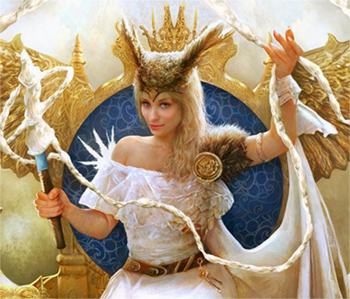 Freyr or Fricco of the Vanir [fertility gods], was brother of Freya ( Freyja: the goddess of love and beauty and sister of Frey. She was the northern Venus and the most beautiful of all the Nordic goddesses. She was married to Odur the god of sunshine, but he left her to roam in distant lands. She followed him, weeping teardrops that changed to gold in the rocks and amber in the sea. She was highly prized by everyone in the nine worlds for her charm and beauty. Freyja was unexpectedly demanded as a wife in payment by the Giant who built the walls around Asgard and trades were offered for her hand in marriage) and son to Njord. He was the Norse god of the sun and rain, and very popular for being the bringer of peace, prosperity, bountiful harvests and fertile marriages. After the war and the joining of the Aesir and the Vanir, Freyr was called ‘Lord of the Aesir’ Paradoxically he was both a god of peace and a warrior god, possessing a magic sword that could emerge from its sheath on its own and spread a field with carnage and death. Also Lord of Alfheim and the ruler of the Elves, Freyr was the most celebrated and most beautiful of the Vanir men, called ‘God of the World’ by the ancient Vikings.
Freyr or Fricco of the Vanir [fertility gods], was brother of Freya ( Freyja: the goddess of love and beauty and sister of Frey. She was the northern Venus and the most beautiful of all the Nordic goddesses. She was married to Odur the god of sunshine, but he left her to roam in distant lands. She followed him, weeping teardrops that changed to gold in the rocks and amber in the sea. She was highly prized by everyone in the nine worlds for her charm and beauty. Freyja was unexpectedly demanded as a wife in payment by the Giant who built the walls around Asgard and trades were offered for her hand in marriage) and son to Njord. He was the Norse god of the sun and rain, and very popular for being the bringer of peace, prosperity, bountiful harvests and fertile marriages. After the war and the joining of the Aesir and the Vanir, Freyr was called ‘Lord of the Aesir’ Paradoxically he was both a god of peace and a warrior god, possessing a magic sword that could emerge from its sheath on its own and spread a field with carnage and death. Also Lord of Alfheim and the ruler of the Elves, Freyr was the most celebrated and most beautiful of the Vanir men, called ‘God of the World’ by the ancient Vikings.
His dear companion, Gullinbursti the wild pig carried him in a chariot made by the dwarfs Brokk and Eitri. He was very similar to the god Apollo of Greek mythology in many ways. He married the beautiful giantess Gerd and the story of how Freyr wooed her is chronicled in the poem Skírnismál. Freyr’s shield bearer and servant was Skirnir, to whom he gave his sword as reward for his perilous journey to the hall of the giant Gymir to procure Gerd for him to be his wife. On the day of Ragnarok he will battle without weapons and be the first to be killed, yes,tThe loss of Freyr’s magic sword will be dearly missed at Ragnarök for Freyr will be killed with a single blow from Surtr, the fire giant.
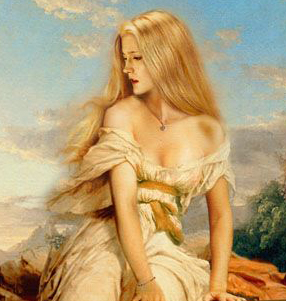 Erda, Queen of the Aesir, Mother of Thor
Erda, Queen of the Aesir, Mother of Thor
Erda, Odin’s wife was an Earth goddess of ancient wisdom. A giantess. An earth-goddess and goddess of wisdom. Daughter of Annar and Nott. Daughter of Odin, some say. First wife of Odin. Mother of Thor. In some stories, she is the daughter of the giantess Fiorgyn and the mother of Frigga, in others she is Fiorgyn. In some accounts, she was one of the Asynjur. She is also called Jord, Jordh, and Fiorgyn(n). The original Valkyries were Odin and Erda’s nine beautiful daughters, who rode winged horses down a rainbow bridge to Earth to collect the souls of the bravest warriors to share in the fellowship of the great hall of the dead- Valhalla. Later their numbers were added to with the finest of mortal women and others.Those strong and beautiful women whom Odin favored, also served unlimited meat and drink all night to the Viking slain, these fallen, called the einherjar would fight all day training for Ragnarok, the great end times battle and then be healed of their wounds only to do it all again, growing ever sharper in Odin’s army.
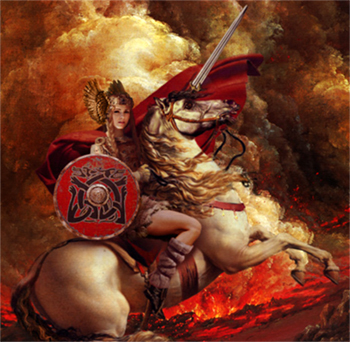 The Valkyries
The Valkyries
The name Valkyrie comes from the Old Norse Valkyrja meaning “chooser of the slain”) and they actually did often determine who lived and died on the battlefield. Scholars have suggested kinships and similarities between the Valkyries, the Norns, the Dísir, Germanic Seeresses, and Shield maidens. The chronology of Norse mythology has a clear beginning in the creation myth, and a clear ending in the tale of Ragnarok. But most of what happens in between those two bookends doesn’t occur in any particular order, and certainly doesn’t follow a strictly linear trajectory. Sometimes, we find that myth A assumes that myth B has already taken place, yet myth B assumes that myth A has already taken place. This is because Norse mythology was never a neat, tidy system; the Viking mind didn’t demand the same kind of strict, rational codification that the modern mind does (or at least thinks it does). Instead, the Vikings seem to have been much more concerned with how much the myths spoke to their hearts and imaginations, as well as the degree to which the myths reflected and made sense of the world as they experienced it.
Norse Mythology | The Aesir-Vanir War – The two tribes of gods fight the first war that was ever fought.
Norse Mythology | The Creation of Thor’s Hammer – Loki stirs up mischief among the dwarves and almost loses his head, but ultimately gives the gods several.
Thanks to all sources for this article: ancient.eu, norse-mythology.org, howarddavidjohnson.com

